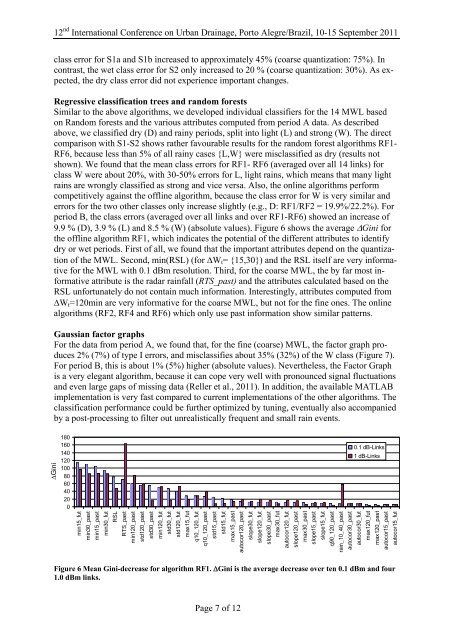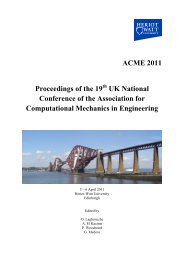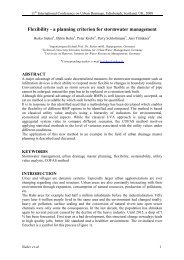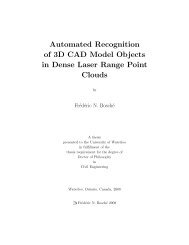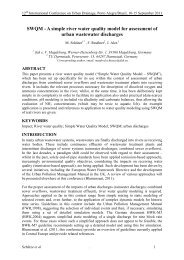Identification of dry and rainy periods using telecommunication ...
Identification of dry and rainy periods using telecommunication ...
Identification of dry and rainy periods using telecommunication ...
You also want an ePaper? Increase the reach of your titles
YUMPU automatically turns print PDFs into web optimized ePapers that Google loves.
12 nd International Conference on Urban Drainage, Porto Alegre/Brazil, 10-15 September 2011<br />
class error for S1a <strong>and</strong> S1b increased to approximately 45% (coarse quantization: 75%). In<br />
contrast, the wet class error for S2 only increased to 20 % (coarse quantization: 30%). As expected,<br />
the <strong>dry</strong> class error did not experience important changes.<br />
Regressive classification trees <strong>and</strong> r<strong>and</strong>om forests<br />
Similar to the above algorithms, we developed individual classifiers for the 14 MWL based<br />
on R<strong>and</strong>om forests <strong>and</strong> the various attributes computed from period A data. As described<br />
above, we classified <strong>dry</strong> (D) <strong>and</strong> <strong>rainy</strong> <strong>periods</strong>, split into light (L) <strong>and</strong> strong (W). The direct<br />
comparison with S1-S2 shows rather favourable results for the r<strong>and</strong>om forest algorithms RF1-<br />
RF6, because less than 5% <strong>of</strong> all <strong>rainy</strong> cases {L,W} were misclassified as <strong>dry</strong> (results not<br />
shown). We found that the mean class errors for RF1- RF6 (averaged over all 14 links) for<br />
class W were about 20%, with 30-50% errors for L, light rains, which means that many light<br />
rains are wrongly classified as strong <strong>and</strong> vice versa. Also, the online algorithms perform<br />
competitively against the <strong>of</strong>fline algorithm, because the class error for W is very similar <strong>and</strong><br />
errors for the two other classes only increase slightly (e.g., D: RF1/RF2 = 19.9%/22.2%). For<br />
period B, the class errors (averaged over all links <strong>and</strong> over RF1-RF6) showed an increase <strong>of</strong><br />
9.9 % (D), 3.9 % (L) <strong>and</strong> 8.5 % (W) (absolute values). Figure 6 shows the average �Gini for<br />
the <strong>of</strong>fline algorithm RF1, which indicates the potential <strong>of</strong> the different attributes to identify<br />
<strong>dry</strong> or wet <strong>periods</strong>. First <strong>of</strong> all, we found that the important attributes depend on the quantization<br />
<strong>of</strong> the MWL. Second, min(RSL) (for �Wt= {15,30}) <strong>and</strong> the RSL itself are very informative<br />
for the MWL with 0.1 dBm resolution. Third, for the coarse MWL, the by far most informative<br />
attribute is the radar rainfall (RTS_past) <strong>and</strong> the attributes calculated based on the<br />
RSL unfortunately do not contain much information. Interestingly, attributes computed from<br />
�Wt=120min are very informative for the coarse MWL, but not for the fine ones. The online<br />
algorithms (RF2, RF4 <strong>and</strong> RF6) which only use past information show similar patterns.<br />
Gaussian factor graphs<br />
For the data from period A, we found that, for the fine (coarse) MWL, the factor graph produces<br />
2% (7%) <strong>of</strong> type I errors, <strong>and</strong> misclassifies about 35% (32%) <strong>of</strong> the W class (Figure 7).<br />
For period B, this is about 1% (5%) higher (absolute values). Nevertheless, the Factor Graph<br />
is a very elegant algorithm, because it can cope very well with pronounced signal fluctuations<br />
<strong>and</strong> even large gaps <strong>of</strong> missing data (Reller et al., 2011). In addition, the available MATLAB<br />
implementation is very fast compared to current implementations <strong>of</strong> the other algorithms. The<br />
classification performance could be further optimized by tuning, eventually also accompanied<br />
by a post-processing to filter out unrealistically frequent <strong>and</strong> small rain events.<br />
�Gini<br />
180<br />
160<br />
140<br />
120<br />
100<br />
80<br />
60<br />
40<br />
20<br />
0<br />
min15_fut<br />
min30_past<br />
min15_past<br />
min30_fut<br />
RSL<br />
RTS_past<br />
min120_past<br />
std120_past<br />
std30_past<br />
min120_fut<br />
std30_fut<br />
std120_fut<br />
max15_fut<br />
q10_120_fut<br />
q10_120_past<br />
std15_past<br />
std15_fut<br />
max15_past<br />
autocor120_past<br />
slope30_fut<br />
Page 7 <strong>of</strong> 12<br />
slope120_fut<br />
slope30_past<br />
max30_fut<br />
autocor120_fut<br />
slope120_past<br />
max30_past<br />
slope15_past<br />
0.1 dB-Links<br />
1 dB-Links<br />
slope15_fut<br />
q90_120_past<br />
rain_10_40_past<br />
autocor30_past<br />
autocor30_fut<br />
max120_fut<br />
max120_past<br />
autocor15_past<br />
autocor15_fut<br />
Figure 6 Mean Gini-decrease for algorithm RF1. �Gini is the average decrease over ten 0.1 dBm <strong>and</strong> four<br />
1.0 dBm links.


